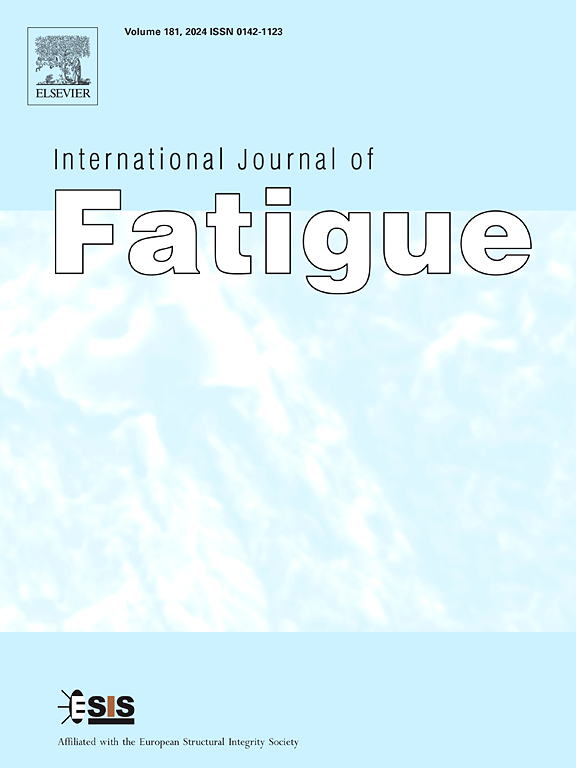Fatigue performance of kiloton CFRP cable after hygrothermal and freeze–thaw cycles
IF 5.7
2区 材料科学
Q1 ENGINEERING, MECHANICAL
引用次数: 0
Abstract
The application of carbon fiber reinforced polymer (CFRP) cable with light weight and high strength can improve the service performance of bridge structures in plateau harsh service environments. But the performance evolution behavior of CFRP cable under complicated service environments of fatigue load, hygrothermal and freeze–thaw cycles is unknown. In this paper, the tensile fatigue performance of CFRP rods used for cable before and after hygrothermal and freeze–thaw cycles is investigated experimentally. The tensile fatigue and residual tensile performances of kiloton CFRP cable are verified after hygrothermal and freeze–thaw cycles. Optical frequency domain reflectometry technology is employed to monitor the stiffness degradation of CFRP cables during fatigue loading. The results indicate that the hygrothermal and freeze–thaw cycles release the residual stress within CFRP rod, which improves the fatigue resistance. By contrast, the hygrothermal and freeze–thaw cycles have no significant effect on stiffness degradation of CFRP rod. The kiloton CFRP cable can withstand 2,000 k cycles of tensile fatigue after hygrothermal and freeze–thaw cycles, and the stiffness degradation of CFRP cable is negligible. The residual tensile bearing capacity of CFRP cable after fatigue is 10,731 kN, corresponding to a residual strength retention rate of 105 %. These findings provide essential validation data for the application of kiloton CFRP cables in bridge construction.
千吨级CFRP电缆在湿热和冻融循环后的疲劳性能
轻质高强碳纤维增强聚合物(CFRP)索的应用可以改善高原恶劣使用环境下桥梁结构的使用性能。但CFRP索在疲劳载荷、湿热循环和冻融循环等复杂使用环境下的性能演化行为尚不清楚。本文对CFRP拉杆在湿热循环和冻融循环前后的拉伸疲劳性能进行了试验研究。试验验证了千吨级CFRP电缆经湿热循环和冻融循环后的拉伸疲劳性能和残余拉伸性能。采用光频域反射技术对CFRP索在疲劳加载过程中的刚度退化进行了监测。结果表明:冻融循环和湿热循环释放了碳纤维布杆内的残余应力,提高了碳纤维布杆的抗疲劳性能;相比之下,冻融循环和湿热循环对碳纤维布杆的刚度退化没有显著影响。千吨级CFRP电缆经湿热和冻融循环后可承受2000 k次的拉伸疲劳,其刚度退化可以忽略不计。CFRP索疲劳后的残余抗拉承载力为10731 kN,残余强度保持率为105%。这些研究结果为千吨级CFRP索在桥梁建设中的应用提供了必要的验证数据。
本文章由计算机程序翻译,如有差异,请以英文原文为准。
求助全文
约1分钟内获得全文
求助全文
来源期刊

International Journal of Fatigue
工程技术-材料科学:综合
CiteScore
10.70
自引率
21.70%
发文量
619
审稿时长
58 days
期刊介绍:
Typical subjects discussed in International Journal of Fatigue address:
Novel fatigue testing and characterization methods (new kinds of fatigue tests, critical evaluation of existing methods, in situ measurement of fatigue degradation, non-contact field measurements)
Multiaxial fatigue and complex loading effects of materials and structures, exploring state-of-the-art concepts in degradation under cyclic loading
Fatigue in the very high cycle regime, including failure mode transitions from surface to subsurface, effects of surface treatment, processing, and loading conditions
Modeling (including degradation processes and related driving forces, multiscale/multi-resolution methods, computational hierarchical and concurrent methods for coupled component and material responses, novel methods for notch root analysis, fracture mechanics, damage mechanics, crack growth kinetics, life prediction and durability, and prediction of stochastic fatigue behavior reflecting microstructure and service conditions)
Models for early stages of fatigue crack formation and growth that explicitly consider microstructure and relevant materials science aspects
Understanding the influence or manufacturing and processing route on fatigue degradation, and embedding this understanding in more predictive schemes for mitigation and design against fatigue
Prognosis and damage state awareness (including sensors, monitoring, methodology, interactive control, accelerated methods, data interpretation)
Applications of technologies associated with fatigue and their implications for structural integrity and reliability. This includes issues related to design, operation and maintenance, i.e., life cycle engineering
Smart materials and structures that can sense and mitigate fatigue degradation
Fatigue of devices and structures at small scales, including effects of process route and surfaces/interfaces.
 求助内容:
求助内容: 应助结果提醒方式:
应助结果提醒方式:


